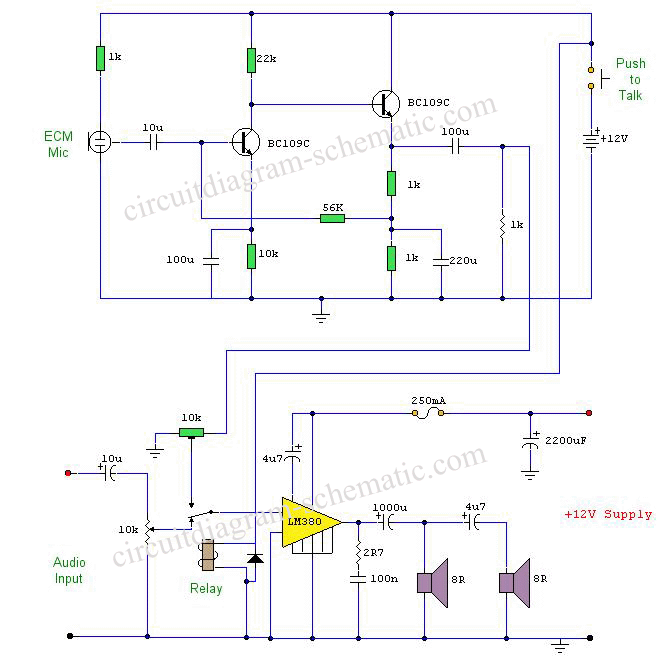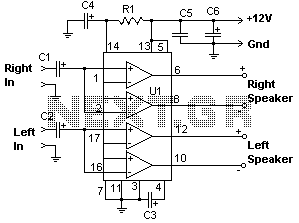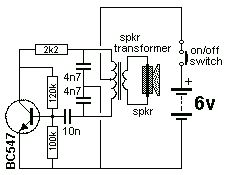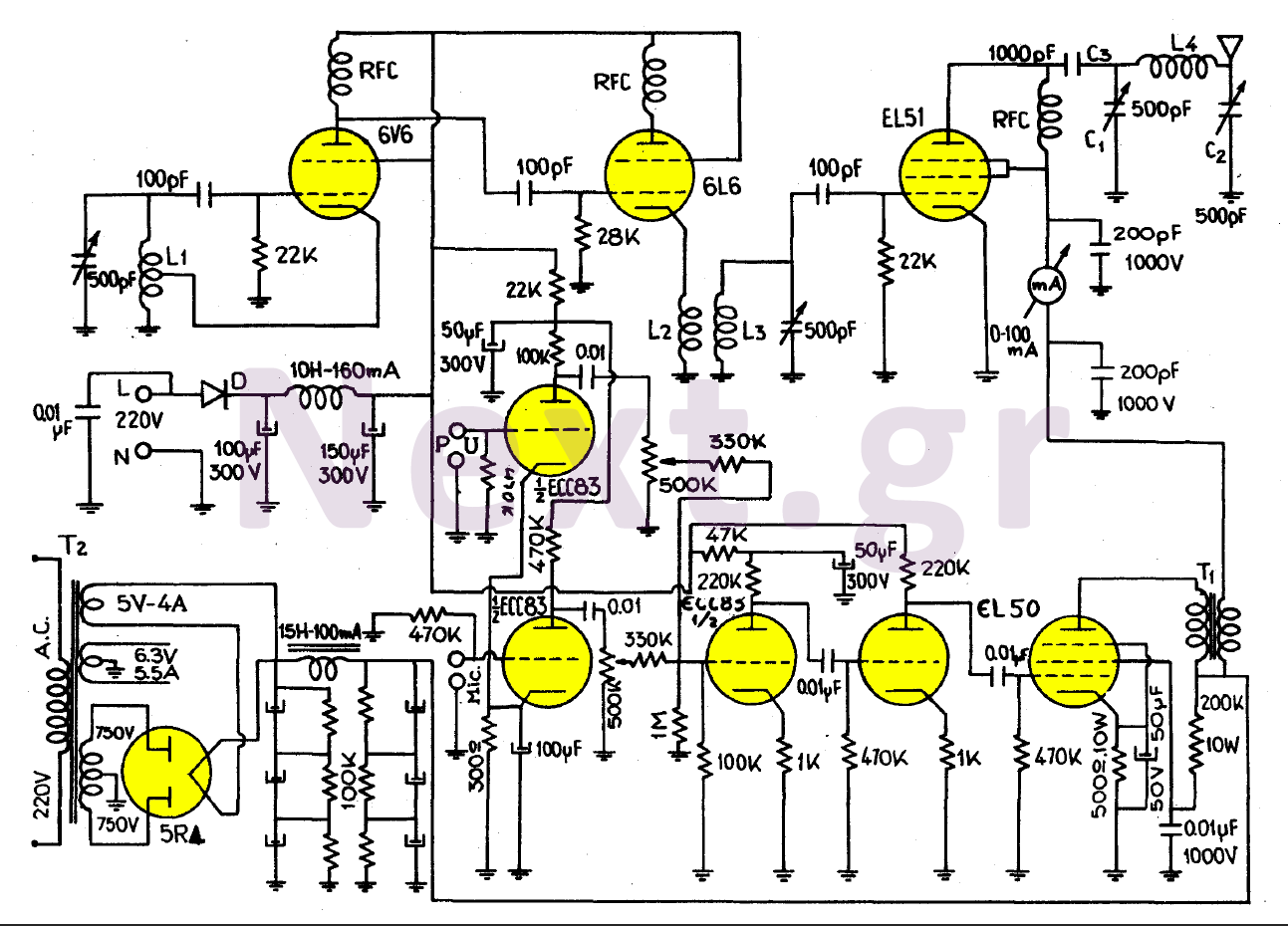
Diesel and Horn Circuit for Train

This circuit is a module for a diesel and horn train system. It is constructed using a 555 timer IC and several operational amplifiers (op-amps). The circuit serves as a complete system for the horn function. The main power supply for the system should be a regulated 12 volts DC, with a minimum input from the train control AC or DC power supply of 13.5 VAC connected to positions 3 and 4 of the rectifier bridge. The ground bus of the regulated 12 volts supply must be connected to the system ground. The independent speed reference voltage can be obtained directly from the train speed control module or by connecting directly from the tracks to positions 5 and 6 of the rectifier bridge. The output from this bridge will always provide a positive speed voltage signal, regardless of the train's direction. While the 555 timer can serve as a voltage-controlled oscillator (VCO), it is not as effective as the LM566. The 555 timer requires a negative voltage range to function properly and produce RPM readings that correlate with actual engine speed; thus, an op-amp is employed to invert the positive track voltage.
This diesel and horn train circuit is designed to integrate seamlessly with the power and control systems of the train. The circuit utilizes a 555 timer IC, which, despite its limitations compared to more specialized components like the LM566, can still function as a basic VCO. The 555 timer operates by generating a pulse width modulation (PWM) signal that can be used to control the horn's activation based on the speed of the train.
The circuit's power supply requirements are critical for stable operation. A regulated 12 volts DC is essential to ensure that all components function within their specified ranges. The 13.5 VAC input to the rectifier bridge allows for the conversion of AC power into DC, which is then regulated to the necessary voltage. The rectifier bridge consists of diodes that allow current to flow in one direction, effectively converting the AC input into a usable DC output.
The connection points on the rectifier bridge (positions 3, 4, 5, and 6) are integral to establishing the circuit's functionality. Positions 3 and 4 are connected to the AC power supply, while positions 5 and 6 are utilized to derive the speed reference voltage. This voltage is crucial for determining the operational state of the train and ensuring that the horn is activated at the appropriate speeds.
The use of operational amplifiers in this circuit serves to enhance its performance. The op-amps are employed to condition the voltage signals, particularly to invert the positive voltage from the track. This inversion is necessary for the 555 timer to accurately interpret the speed of the train, as it requires a negative voltage range for proper operation. By inverting the voltage, the op-amps enable the 555 timer to produce a signal that correlates with the actual engine speed, allowing for precise control of the horn.
Overall, this circuit represents a well-thought-out integration of components that work together to provide a reliable and effective system for controlling the horn of a diesel train based on its speed. The careful consideration of power supply, voltage conditioning, and component selection contributes to the circuit's efficacy in a practical application.This is a one module of diesel and horn train circuit. This circuit is work with built by 555 timers IC, and some op amp. This circuit is a complete system for the horn circuit. This is the figure of the circuit. The main power supply to the system must be a regulated 12 volts DC with a minimum input from the train control AC or DC power supply of 13. 5 VAC connected to pos 3 and 4 of the rectifier bridge. The ground bus of the regulated 12 volts supply must be connected to the system ground. The independent speed reference voltage is taken directly from the train speed control module or can be taken by connecting directly from the tracks to positions 5 and 6 of the rectifier bridge. The output of this bridge will always be a positive speed voltage signal whichever direction the train is going.
The 555 timer is really a poor replacement for the LM566 as a VCO (Voltage controlled oscillator) although it is linear in function a negative voltage range is needed to activate the timer and produce the RPM to relate to the actual engine speed thus the op-amp is used to invert the track positive voltage. 🔗 External reference
This diesel and horn train circuit is designed to integrate seamlessly with the power and control systems of the train. The circuit utilizes a 555 timer IC, which, despite its limitations compared to more specialized components like the LM566, can still function as a basic VCO. The 555 timer operates by generating a pulse width modulation (PWM) signal that can be used to control the horn's activation based on the speed of the train.
The circuit's power supply requirements are critical for stable operation. A regulated 12 volts DC is essential to ensure that all components function within their specified ranges. The 13.5 VAC input to the rectifier bridge allows for the conversion of AC power into DC, which is then regulated to the necessary voltage. The rectifier bridge consists of diodes that allow current to flow in one direction, effectively converting the AC input into a usable DC output.
The connection points on the rectifier bridge (positions 3, 4, 5, and 6) are integral to establishing the circuit's functionality. Positions 3 and 4 are connected to the AC power supply, while positions 5 and 6 are utilized to derive the speed reference voltage. This voltage is crucial for determining the operational state of the train and ensuring that the horn is activated at the appropriate speeds.
The use of operational amplifiers in this circuit serves to enhance its performance. The op-amps are employed to condition the voltage signals, particularly to invert the positive voltage from the track. This inversion is necessary for the 555 timer to accurately interpret the speed of the train, as it requires a negative voltage range for proper operation. By inverting the voltage, the op-amps enable the 555 timer to produce a signal that correlates with the actual engine speed, allowing for precise control of the horn.
Overall, this circuit represents a well-thought-out integration of components that work together to provide a reliable and effective system for controlling the horn of a diesel train based on its speed. The careful consideration of power supply, voltage conditioning, and component selection contributes to the circuit's efficacy in a practical application.This is a one module of diesel and horn train circuit. This circuit is work with built by 555 timers IC, and some op amp. This circuit is a complete system for the horn circuit. This is the figure of the circuit. The main power supply to the system must be a regulated 12 volts DC with a minimum input from the train control AC or DC power supply of 13. 5 VAC connected to pos 3 and 4 of the rectifier bridge. The ground bus of the regulated 12 volts supply must be connected to the system ground. The independent speed reference voltage is taken directly from the train speed control module or can be taken by connecting directly from the tracks to positions 5 and 6 of the rectifier bridge. The output of this bridge will always be a positive speed voltage signal whichever direction the train is going.
The 555 timer is really a poor replacement for the LM566 as a VCO (Voltage controlled oscillator) although it is linear in function a negative voltage range is needed to activate the timer and produce the RPM to relate to the actual engine speed thus the op-amp is used to invert the track positive voltage. 🔗 External reference
Warning: include(partials/cookie-banner.php): Failed to open stream: Permission denied in /var/www/html/nextgr/view-circuit.php on line 713
Warning: include(): Failed opening 'partials/cookie-banner.php' for inclusion (include_path='.:/usr/share/php') in /var/www/html/nextgr/view-circuit.php on line 713





